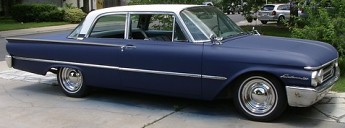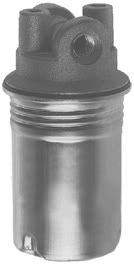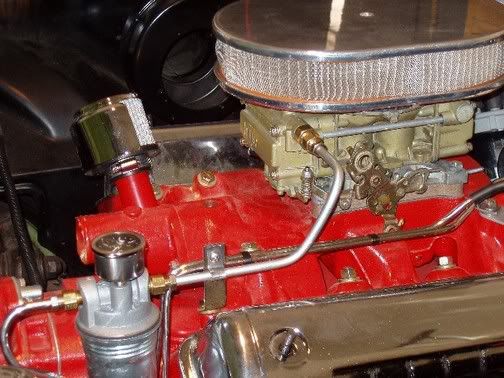|
Author
|
Message
|
|
HoLun
|
|
|
Group: Forum Members
Last Active: 4 Years Ago
Posts: 197,
Visits: 1.4K
|
So the Engine is about 1000 miles since the rebuild, I did the go 50 mph and let the engine slow the car down to 20 thing a few time, in 3rd gear and in 2nd gear, the there still a little smoke from burning oil coming out of the tail pipe after it idle for a little bit, the plugs are coated with chunks of burnt oil, I wonder if it is because the rings are not seated yet or the umbrella valve stem seal not doing its job... the piston rings are total seal gapless second ring, with moly top ring. on the battery relocation, I have my toolbox at the passenger side in the trunk, I have also updated the rear with a traction-lok differential. car gets tail happy on smooth road on turns in 1st gear... anyone know if its possible to powerslide with a car that 4000 lb and with a 30:1 manual steering box? lol 

|
|
|
|
|
GREENBIRD56
|
|
|
Group: Forum Members
Last Active: Last Year
Posts: 1.7K,
Visits: 102.7K
|
Holun - What are your plugs looking like at this state of tune? Hope you haven't had to use too much fuel to get things going. A little extra idle speed can help some with a lumpy cam - have you increased it a bit? The old school way of picking a rear gear for a street car - the tranny low times the rear end ratio must equal "10" or so - more depending on the gross vehicle weight. With your 2.78 low and a 3.73 the total ratio would come up to 10.37:1. This isn't for a hardcore street racer -but a stoplight bandit that goes cruz'in. If you want her to dig out - for a start - the right rear spring preload should be: Engine starting line torque (ft-lbs) x total gear ratio (like the 10.37:1 above) divided by the distance between spring perches on the rear housing (in feet). This result is a weight that needs to be biased onto the right rear to counteract the tendency of the axle housing to rotate around the driveshaft. If the engine torque when you dump the clutch is 200 ft-lbs and the ratio is as above - and the spring perches are 4 ft apart - the result is about 520 lbs. You can tell - by simply sitting on the right rear fender that this can really settle the spring a bunch. Traction bars are nice - like slappers or the Shelby style links - but they won't do it all, something has to happen to bias the weight. Two things that have a really positive effect on this - move the battery to the right rear behind the axle (put it in a sealed box) and put a spacer above the left front spring. Both of these work pretty good on a street car without upsetting the ability to drive it around. After you do this you may find that you need to either get the RH rear spring re-arched or (like a Mopar muscle car) add a leaf.

Steve Metzger Tucson, Arizona
|
|
|
|
|
HoLun
|
|
|
Group: Forum Members
Last Active: 4 Years Ago
Posts: 197,
Visits: 1.4K
|
I fixed the 2300rpm hiccup and other related bog at wot, the stupid me went and open the secondary throttle plate when not needed, close the throttle plates up and now I can spin both my rear wheels at the stop sign for a bit, good thing there were no cops around haha. the spin is not perfectly smooth, I guess thats from wheel hop because of the leaf springs. I have a 1/2" plastic spacer, its a 4 hole design, with the "torq-swirl" slot cut it in to spin the air?? it was not too expansive so I got that one. by more gear u mean something like 3.75 or 4.00 rear gears? the cam specs that on the card are: In.opens 28 closes 64 Ex.Opens 64 Closes 28 Duration at .050 224* both in and ex In Valve Lift .446 Ex Valve lift .446 lash is .018 for both from claysmith engineering

|
|
|
|
|
GREENBIRD56
|
|
|
Group: Forum Members
Last Active: Last Year
Posts: 1.7K,
Visits: 102.7K
|
Holun - I dug out some of my stuff on cam design/selection and interpreted the numbers you gave me as best I can. The cam specs you listed are from a symmetrical cam - both lobe shapes and timng durations are the same - they are simply offset on the shaft to provide the same ramps to both valves at an offset angle. (They are cheaper to construct too.) Per the spec's info you gave us to work with - The duration (at whatever lash the spec was written) is 272° The overlap is 56° The lobe centerline angle is 108° - is this correct? Knowing the gross cam lift and rocker ratio would be good. This would be a nice cam in a bigger engine (like a 350 with bigger valves) - but in your 292 may not be fun to live with - except at the drag strip - and you will need more gear in the punkin. If its installed right on the split overlap, two things will help right away - decrease the overlap angle (by increasing the lash clearance setting) - and Ted may best know what your limits can be - and decrease the tendency of the engine to lose vacuum at the overlap. Do you have an open spacer under the carb - or one with individual holes to isolate the halves of the dual plane intake manifold? If the spacer is open the overlap is "stealing" a ton of vacuum - and you need venturi vacuum to make a street engine (and carburetor) run well. This type of engine needs a 4 hole spacer with individual openings to make the cylinders fill.

Steve Metzger Tucson, Arizona
|
|
|
|
|
HoLun
|
|
|
Group: Forum Members
Last Active: 4 Years Ago
Posts: 197,
Visits: 1.4K
|
The cam card says intake opes at 28* closes at 64* exhaust opens at 64* closes at 28* when i say it ran bad, it feels like its missing all the way to redline, I dont feel any massive torque, but it doesnt want to rev. I lash the valves when the cylinder is TDC on power stroke, would this have caused some problems? I opened the seconday a little to get it idle with minimal amout of idle screw, donno if that will cause that hiccup at 2300rpm, I dont know if at that point its too rich or too lean, it sound like an exhaust backfire, I wish I have an air fuel meter to help tune this thing. I set the flow level higher, and the off the line low rpm part throttle take off stumble is complete gone. but i think i set it a little too high, feels like its loaded up sometimes. I am going to mess with the carb some more.

|
|
|
|
|
GREENBIRD56
|
|
|
Group: Forum Members
Last Active: Last Year
Posts: 1.7K,
Visits: 102.7K
|
Geez guys - we'll never get Holun's car to run .....................John - look at the old Forum first page of tech - "FuelFilter". I put a web address in there for a new one. The filter unit is on the motor is an AC Delco GF62 and I got the upper housing off ebay for 5 bucks. The tin can lower came from a "rummage sale" at NAPA - it usually goes on one of the Ford truck fuel pumps (among other spots). I recently saw a bowl/housing that was all printed up in red with the Ford "FOMOCO" service stuff and someday.....I'll get one cheap. The housing has two 5/16 fine thread attachment holes in the top and I drilled one through and out to 1/8 pipe so I could put the fuel pressure gauge on there. 
The breather is from Moroso (Jegs 710-68811/15) and it was the only pleated element, shielded style I could find that was advertised to fit a 1-3/8 vent tube. The only drawback is that it says "MOROSO" on the top - and its nothing personal, there are Moroso parts on virtually everything I've built - but I wanted a "no-name" shiney part there. My machinist buddy says no worries he'll make me a little finned disc to fit on top to match the T-bird valve covers (that I have been polishing on for an eternity). "No worries" is usually a lunch bill or two.

Steve Metzger Tucson, Arizona
|
|
|
|
|
Hoosier Hurricane
|
|
|
Group: Moderators
Last Active: Yesterday
Posts: 3.7K,
Visits: 322.9K
|
AZ28: What is that fuel filter on your engine? John
John - "The Hoosier Hurricane"

|
|
|
|
|
GREENBIRD56
|
|
|
Group: Forum Members
Last Active: Last Year
Posts: 1.7K,
Visits: 102.7K
|
Holun - Did you get a timing card with the cam you put in your engine? I couldn't find any mention in the threads - but I did go through pretty quickly. I'm curious whether it is symmetrical or has a "Dual Pattern" with exhaust timing modifications. If its symmetrical, I was thinking that you might take off the right hand valve cover and find the approximate "split overlap" point of the cam by following the #1 rockers with a couple of dial indicators. Set the lash equal and then with the exhaust closing and the intake opening, find the spot where the lift is equal on both lobes. That point should have a definite relationship to the TDC mark on your crank dampener. Advancing the cam as Ted suggested - should have worked. Over-advancing it would make the engine feel like it belongs in a tractor - massive torque and not want to rev at all. Retarding it makes the engine struggle to get up to speed then smooth out as the revs rise. You said it ran bad - which was it? 
Another carb tuning item you might fool with, is the spring on the accelerator pump actuator. Crushing it down to "coil bind" isn't always best - if it has some travel, the "cushion" continues to stroke the pump after movement of the throttle stops. This has a relationship to the shooter size, but it does offer a little different behavior of the pump shot.

Steve Metzger Tucson, Arizona
|
|
|
|
|
Ted
|
|
|
Group: Administrators
Last Active: Yesterday
Posts: 7.4K,
Visits: 205.8K
|
For trying to resolve a flat spot or hesitation in the acceleration, I'd suggest trying the extremes in fuel shooter sizes to first determine if the engine is either getting too much fuel or not enough. Pump cams will not have the immediate effect that the shooter sizes will. I've seen those instances where too much 'shooter' fuel will create a hestitation just as well not having enough. I'd suggest trying the #25 shooter size first just to get a feel for what the smallest shooter size does and then if necessary, work from the other direction. If using a #25 shooter helps, then work with the pump cams to further reduce the accelerator pump shot. Other players also includes the fuel float level, primary fuel jetting, and idle mixture. All these also affect fuel delivery at the intermediate rpms. The secondary side float level is also a player as that affects the 'fixed' idle mixture on the secondary side which ultimately affects the primary side. And don't forget about vacuum leaks; these will make you run in circles trying to work around them and a vacuum gauge will not necessarily pick those up if they're small.
  Lorena, Texas (South of Waco) Lorena, Texas (South of Waco)
|
|
|
|
|
HoLun
|
|
|
Group: Forum Members
Last Active: 4 Years Ago
Posts: 197,
Visits: 1.4K
|
did some more tuning, back the timing down to 16btdc, delay the advance curve max advance from 2500rpm to 2800rpm, played with the accelerator pump nozzles, and cams, changed from .035 to .031. dont seem to change much. when doing quick revs in neutral, it have a slight hiccup at about 2300rpm, the vacuum gauge shows thats when the vacuum starts to climb back up, only hiccup at WOT revs and hard acceleration at low gear. changing the accelerator pump cam seem to effect how bad the hiccup is, but I can't eliminate it. any thoughts?

|
|
|
|